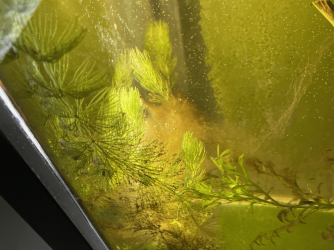kribensis12
I know where you live
In my 10g breeding tank for Apistogramma cacatouides, there is a lot of algae... I'll own up to it - when I first installed their LED light it ran for 12-14 hours a day due to my work schedule and caused the algae bloom. The Bristlenose in the tank does not touch the algae, which surprises me because in my past experience I've found them to be very good at cleaning algae.
With that being said, I recently introduced some Mopani wood which obviously caused a bacteria laden film to appear around the wood.
Just prior to introducing the wood, I had begun to notice some of the plants beginning to have a "film" or "cloud" (for lack of a better word) beginning around them. The hornwort in the provided photos look to be covered in debris, as if I were overfeeding. I feed 2x a day and just a little bit of flake food - enough for the breeding pair, nothing addition. You can see the new growth on the hornwort as it's clean and bright green.
I stopped adding nutrients for the plants a month ago, the tank now has 8hrs of light (4 hours on, 4 hours off, 4 hours on) and I have been continuing to keep up on my water changes.
Readings are: Ammonia: 0, Nitrite: 0, Nitrate <0-5 depending on how close it is to W/C day. Currently, 0.
I have provided some pictures - any insight would be helpful! It's obviously not harming the fish, but the tank looks disgusting!
With that being said, I recently introduced some Mopani wood which obviously caused a bacteria laden film to appear around the wood.
Just prior to introducing the wood, I had begun to notice some of the plants beginning to have a "film" or "cloud" (for lack of a better word) beginning around them. The hornwort in the provided photos look to be covered in debris, as if I were overfeeding. I feed 2x a day and just a little bit of flake food - enough for the breeding pair, nothing addition. You can see the new growth on the hornwort as it's clean and bright green.
I stopped adding nutrients for the plants a month ago, the tank now has 8hrs of light (4 hours on, 4 hours off, 4 hours on) and I have been continuing to keep up on my water changes.
Readings are: Ammonia: 0, Nitrite: 0, Nitrate <0-5 depending on how close it is to W/C day. Currently, 0.
I have provided some pictures - any insight would be helpful! It's obviously not harming the fish, but the tank looks disgusting!






